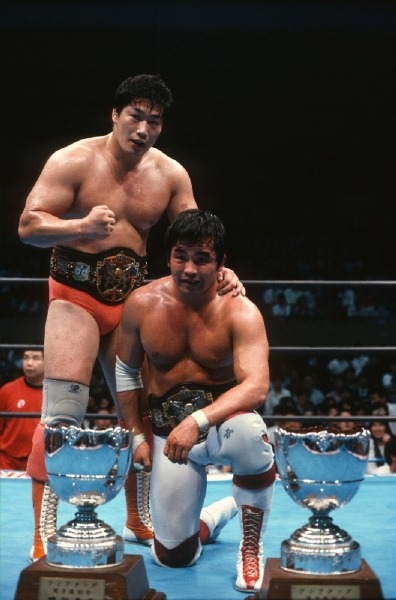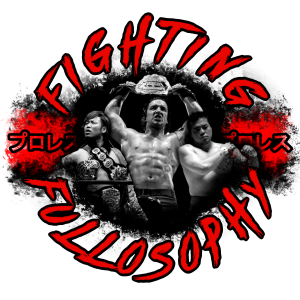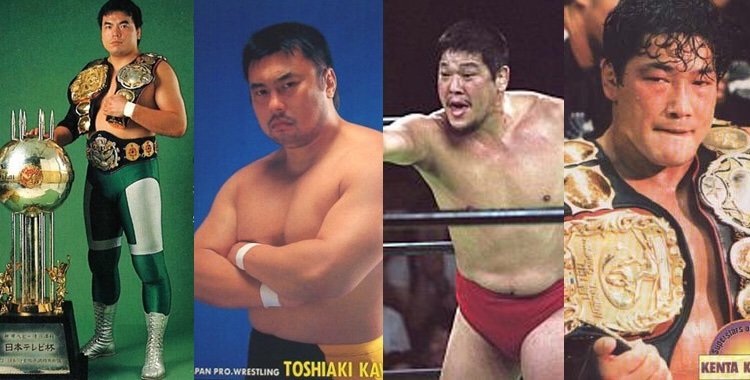Welcome to Part 3 of Walking the King’s Road, an introductory guide to one of the greatest periods in wrestling history. Over the first two parts, we’ve explored how Giant Baba was forced to rebuild his roster and how that lead to one of the greatest rivalries the wrestling world has ever seen. However, Misawa vs Kawada wasn’t the only legendary rivalry that All Japan would have during the 90’s. From 1995 onwards, Mitsuharu Misawa and Kenta Kobashi would enter into a feud that would rival that of Misawa vs Kawada. It would showcase the same level of hard hitting innovation, deep storytelling and intense fighting spirit.
Before we get Part 3 under way, if you have missed either Part 1 or 2 then you can find them using the links below:
Part 1 – The Birth of a Dynasty
Part 2 – Mitsuharu Misawa vs Toshiaki Kawada
Part 3 – Mitsuharu Misawa vs Kenta Kobashi

If Misawa vs Kawada was a feud built on a deep personal hatred, then Misawa vs Kobashi was a feud built on respect. While neither man would hold nothing back in the ring, they would still maintain a healthy respect for one another. This rivalry would morph from who was the better man into who was the true Ace as we entered the latter part of the 90’s. Kobashi was so beloved by the fans that his popularity would start to rival that of Misawa’s and thus lead to his challenge as the Ace of All Japan.
Before we dive into this feud, I’d like to shed a little light on Kobashi’s history and growth leading up to his first match against Misawa in 1995. This time period would feature many struggles for the young Kobashi. However, these hurdles would help to shape Kobashi into the fearless, ferocious warrior he’d become.
Kobashi would apply and be accepted into the AJPW Dojo in the summer of 1987. He would debut in February of 1988 and go on to lose his first 63 matches, all of them singles bouts. On the surface that might sound like a burial but it was all part of Baba’s plan as Kobashi would shine even in defeat.
Showing incredible heart, fire, passion, determination and fighting spirit, Kobashi was far from an easy out in these matches. And as time passed, the fans became drawn to this young rookie who would never quit. Willing him on in the hope of seeing his first victory. So strong was this reaction that Kobashi would win multiple Rookie of the Year awards from the Japanese press.

That elusive first win would come in February on 1988 and in April of 1990 he would win his first championship gold. This would come in the form of the All Asia Tag Team Championship alongside Tiger Mask II. The reign itself would be short lived, in May Misawa would unmask and soon vacate the titles to focus on his singles career. Undeterred by this set back, Kobashi would join forces with Misawa in his war against the old guard of All Japan. During this time Kobashi would serve two roles.
When teaming with the higher ranking Misawa and Kawada, Kobashi would be the fiery underdog. When teaming with Tsuyoshi Kikuchi, Kobashi would serve more as a big brother coming to the rescue. This partnership with Kikuchi would give Kobashi his first Match of the Year in 1992. The two would challenge Dan Kroffat and Doug Furnas for the All Asia Tag Team titles (a match we’ll look at in Part 5).
1993 to 1995 would be a period of tremendous growth for Kobashi. He would primarily serve as Misawa’s tag team partner which would lead to Kobashi’s first World’s Strongest Tag Determination League win and first World Tag Team title reign. Singles success would slowly start to come as well. Wins over former Triple Crown champions would lead to a number of Triple Crown challengers for Kobashi. The most notable of these was the 60 minute time-limit draw against Kawada which was mentioned in Part 2.
With a wealth of experience now under his belt, Kobashi was finally ready to make his first challenge against Misawa for the Triple Crown. This leads us to the first match we’re going to take a look at in this part.
AJPW TRIPLE CROWN TITLE MATCH: MITSUHARU MISAWA (C) VS KENTA KOBASHI – OCTOBER 25TH 1995
Before the bell even rings, the respect these two men have for each other is on full display as they exchange a handshake. Kobashi is still working with the knee injury we saw in his and Misawa’s World Tag Team title match against the Holy Demon Army a few months prior. You can’t tell Kobashi is battling injury as the opening five minutes features beautiful chain wrestling as both men feel the other out.
Both have an answer for the other’s strikes until Kobashi side steps a Misawa flying elbow strike. Keen to prove himself, Kobashi takes advantage of this opening by delivering an Orange Crush on Misawa. The veteran Misawa roles out of the ring seemingly away from danger. However, Kobashi has other plans as he follows Misawa to the outside to deliver a vicious powerbomb on the floor.
Kobashi proceeds to press the advantage and take the fight to a now reeling Misawa. Several big shots are not enough to keep Misawa down, who desperately attempts to create separation. Even when he does escape Kobashi’s grasp, Misawa is unable to hold the advantage for long. A series of hard and heavy blows from Misawa only fires up Kobashi who shows his fighting spirit and heart by pushing through the pain to regain the advantage. Ultimately, Kobashi costs himself the advantage with a failed attempt at a backdrop suplex off the apron. Here we see Misawa’s resiliency on full display as he’s weathered the storm and begins to take control of the match.
As the matches reaches its closing stretch we see a return of the frantic pace. The momentum swings back and forth with neither able to maintain an advantage. A combination of Tiger Suplex and Tiger Drivers aren’t enough to keep the plucky Kobashi down for three. It take Misawa dropping Kobashi on his head with a nasty Tiger Driver to keep him down.
Post-match, Misawa shows tremendous respect for his opponent and friend. First, by checking on his condition and then thanking him in the post-match interview as Kobashi is being carried to the back. While Kobashi might not have won the title on this night, he proved that he belonged with the elite of All Japan. A position he would solidify on the 24th of July 1996 by beating Akira Taue to earn his first Triple Crown Championship.
AJPW TRIPLE CROWN TITLE MATCH: KENTA KOBASHI (C) VS MITSUHARU MISAWA – JANUARY 25TH 1997
This would be the first of three Triple Crown Championship matches Misawa and Kobashi would have in 1997. Here Misawa is challenging the more confident and seasoned Kobashi. The story of this match is a wonderful reversal of roles from their encounter in 1995. It’s Misawa that controls the opening portion of the match with a hard hitting fast paced attack. The answer from Kobashi shows his growth as he manages to slow down sections of the match with a variety of submissions. Kobashi utilises his wealth of experience to avoid an elbow suicida which injuries Misawa’s right elbow after it impacts the guard rail.
With Misawa’s greatest weapon now in jeopardy, Kobashi wastes no time going on the offensive. Each attack is targeted at the arm through a combination of submissions and rakes using different parts of the ring. Again, we see another example of the incredible resiliency and heart Misawa had. Fighting through the pain racing through his elbow, Misawa throws caution to the wind and continues to use his greatest weapon to regain control.
We now reach a stalemate as both Misawa and Kobashi search for a way to maintain the advantage. In an act of desperation, Kobashi attempts to powerbomb Misawa off the apron to the floor. An act that would cost Kobashi greatly as Misawa is able to counter it into a hurricanrana.
Nearly 35 minutes into the match and both men slowly drag themselves into the ring. Completely spent, both slowly crawl towards one another to resume the fight. This closing stretch is a series of big moves as each man attempts to finish the other. Eventually, Misawa is able to prevail with a Tiger Suplex followed by a vicious flying elbow that keeps Kobashi down and end his first Triple Crown Championship reign.
AJPW TRIPLE CROWN TITLE MATCH: MITSUHARU MISAWA (C) VS KENTA KOBASHI – OCTOBER 21ST 1997
The final match in their 1997 trilogy would receive the Bout of the Year award from Tokyo Sports. Despite meeting twice that year, the third match is just as dramatic and breath-taking as their previous encounters. Kobashi would again be fighting though a knee injury, one of many throughout his career. As with their 1995 encounter, this injury wouldn’t slow down Kobashi as the two wrestle at a frantic pace. This is the first time we see dives start to take a prominent place along with an increased focus on both men dropping the other on their head. These two characteristics would go on to define this feud and increase with each passing match.
We also see a new tactic from Kobashi in this match, one that focuses on a strong submission game. While submissions had played a part in their previous matches, Kobashi’s injured knee eventually forces him into the ground game. The target on this occasion is Misawa’s neck as Kobashi slowly grinds down the champion. I also like to think this is another sign of growth from Kobashi. In their previous meetings, it was the high risk offence that cost Kobashi. Maybe this is a sign of him adapting and trying to find a different way to win.
As with many of the matches in this series, we reach a stalemate towards the end of the match. Despite the pain and exhaustion of an intense battle, neither man is willing to back down or give up. This is reflected in a moment where both men charge at the other to deliver their signature strikes. The result is both Misawa and Kobashi crumbling to the mat. Again, Misawa has to rely on a Tiger Driver to dump Kobashi on his neck to secure the win. A move that would force Kobashi to retaliate with a vicious move of his own. But through all of this we see another sign of respect as Misawa and Kobashi exchange a handshake post-match.
JINSEI SHINZAKI & KENTA KOBASHI VS MITSUHARU MISAWA & TAKAO OMORI – OCTOBER 24TH 1998
While this is the shortest match we’ll look at, it carries great significance. This was the moment when Kobashi would introduce one of, if not the, most dangerous moves to his arsenal. The Burning Hammer would become synonymous with Kobashi as it was an instant match ending move. The shock and horror on the announcers voice is plain to hear as he tries to process what he’s just seen. Remember, it took Kawada minutes of double team moves with Taue to earn his first pinfall over Misawa. For Kobashi, the Burning Hammer ended the fight within minutes and earned him the right to challenge Misawa for the Triple Crown.
AJPW TRIPLE CROWN TITLE MATCH: MITSUHARU MISAWA ( C ) VS KENTA KOBASHI – OCTOBER 31ST 1998
I’ll be completely honest here, this is my personal favourite match of all time so I’m a little biased. Instead of doing a deep dive, I’ll only highlight a few points and let you enjoy this incredible match for yourself. Like with Kawada’s challenge in July of 1995, this is the first time Kobashi is seen as Misawa’s equal. In fact at this point in history, Kobashi had taken Kawada’s place as Misawa’s greatest rival. This is reflected in the match as Kobashi is able to control large portions and has an answer to many of Misawa’s moves. Which leads to Misawa having to create new moves to gain the advantage. Perhaps the most important aspect of this match is that Kobashi is unable to hit the Burning Hammer on Misawa.
A moment that truly stands out to me is in the post-match once Misawa is backstage. Seeing the need for him to have his neck stretched is a sobering reminder of the price this style took on the wrestler’s bodies. Both this match and the previous one we looked at would take home the Best Bout Award from Tokyo Sports. The first of all two times such a feat was accomplished (Omega vs Okada in 2017 and 2018 were the second).
AJPW TRIPLE CROWN TITLE MATCH: MITSUHARU MISAWA VS KENTA KOBASHI – JUNE 11TH 1999
The final Triple Crown encounter between these two titans is wrestled at a very different pace. From the opening bell this is a technical, largely mat based masterpiece. Yes the big dives, hard strikes and brutal power moves are still there. But they are used to compliment the work that has already been done on the mat. The submissions, counters and transitions are a testament to just how technically sound both Misawa and Kobashi were.
Kobashi controls the opening pace by targeting the head and neck of Misawa. After all the years of abuse, Misawa’s neck is his weak point and he tries desperately to escape Kobashi’s clutches. As Misawa starts the striking game, Kobashi turns his attention to Misawa’s arms in an attempt to take away his greatest weapon. A weapon that had repeatedly knocked out Kobashi in the past and cost him the match. This game of chess continues as Misawa repeatedly tries to get Kobashi to wrestle his match by unloading huge dives. However, Kobashi manages to withstand this attack and bring the pace back to his liking.
Eventually, Misawa is able to hit a big enough move to create the space he so desperately needs. And with that the momentum brings to swing as Misawa is able to put together some sustained offence. While Kobashi wouldn’t go down without a fight, the pace slowly turns to the advantage of Misawa. The closing stretch see a return of the pace we’re familiar with as again both men try to hit that one big move to keep the other down. Once more, Kobashi is unable to hit the Burning Hammer on Misawa who manages to muster enough strength to connect with the Emerald Flowsion for the win.
GHC HEAVYWEIGHT TITLE MATCH: MITSUHARU MISAWA ( C ) VS KENTA KOBASHI – MARCH 1ST 2003
Okay, I know this is technically cheating as the match happened in Pro Wrestling NOAH. But it would be remiss of me to not include this match. Neither man misses a beat as we see the same fast paced, hard hitting offense that is on display during their previous encounters. In fact, this is by far the most brutal and violent of their battles. Misawa and Kobashi repeatedly drop the other on their head both in the ring and on the floor.
Misawa’s mouth is cut open early on from reversed dive that sends him face first into the guard rail. Kobashi follows this up with a half-nelson suplex that plants Misawa on the top of his head on the floor. Misawa would eventually return the favour with one of the most dangerous spots of all time. With both men on the walkway, Misawa proceeds to deliver a Tiger Suplex off the ramp and onto the floor below. Somehow, Kobashi manages to reach down and battle back to deliver a Burning Hammer to seal his first GHC Heavyweight title. This would be the first time Kobashi would beat Misawa in a singles match with championship gold on the line.
The sheer brutality and violence of this match perfectly encapsulates this rivalry as a whole. Both men would constantly push each other to their absolute limit and challenge the other to innovate in order to win. It’s a battle of heart, spirit and will between two of the greatest to step foot in a ring. And yet throughout the course of these wars, both men retained a level of respect for the other. This was purely about the thrill of the fight and who was the better man.
Having two of the greatest rivalries of all time in one promotion at the same time is a rarity in wrestling. It speaks to the incredible talent and depth that All Japan possessed at this point in history. And to the vision Giant Baba had to place this amazing talent in a position to succeed. However, it wasn’t just the Four Pillars of Heaven that contributed to AJPW’s success. Baba would rely on a deep and equally talent pool of gaijin who would serve as the backbone of the promotion. We will take a look at some of these gaijin in Part 4 as we continue our journey down the King’s Road.



